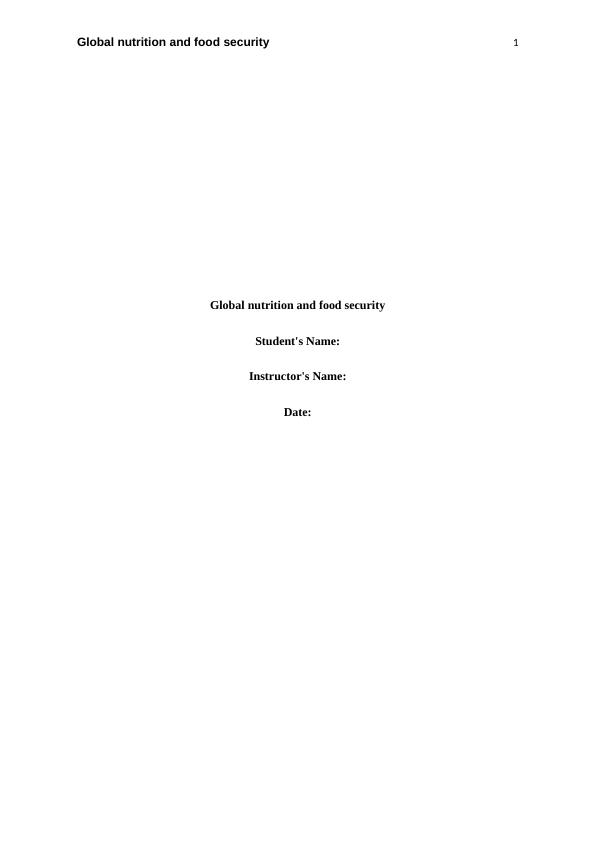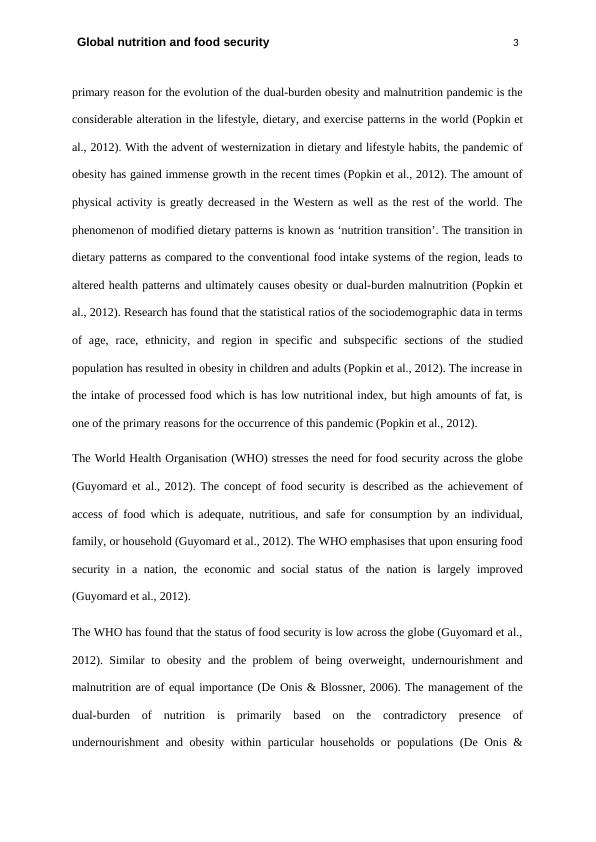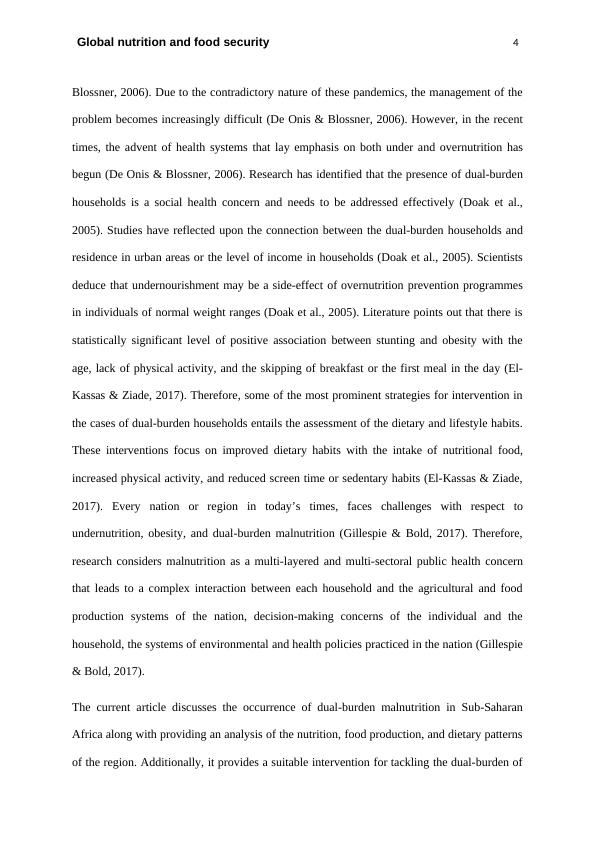005GSID - Global Nutrition and Food Security
Added on 2020-03-02
14 Pages3779 Words87 Views
Global nutrition and food security 1Global nutrition and food securityStudent's Name:Instructor's Name:Date:

Global nutrition and food security 2Global nutrition and food securityIntroduction:The dual-burden of nutrition is essentially described as a state of co-existence of stunting orundernourishment (malnutrition) or obesity due to over nutrition (Varela-Silva et al., 2012).The coexistence is found to be present in the same group of people and the same populationsample i.e. belonging to a particular location, ethnicity, or population (Varela-Silva et al.,2012). Further, the coexistence may occur in the same individual, family, or household(Varela-Silva et al., 2012). The phenomenon described above has been termed ‘dual-burdenmalnutrition’ and has been noticed predominantly in the developing, underdeveloped, andlow or middle-income nations or continents (Varela-Silva et al., 2012). The problemsassociated with malnutrition and the nutritional dual-burden have been examined in researchin the more recent times (Varela-Silva et al., 2012). The dual-burden of malnutrition havebeen observed in households of the low and middle-income and developing nations (Varela-Silva et al., 2012). The most commonly noticed issues related to malnutrition includeunderdevelopment of height and appropriate values of weight (Varela-Silva et al., 2012).Obesity in infants is commonly mistaken for optimal nourishment which leads to increaseddifficulty in the management of the nutritional dual-burden concern (Varela-Silva et al.,2012). Research has observed that the occurrence of underdevelopment of height and beingoverweight are contradictory to the biological nature of human development (Varela-Silva etal., 2012). These occurrences have not been predicted in the conventional food systems ornutritional bases (Varela-Silva et al., 2012).Dual-burden of nutrition is a relatively recent pandemic that has been affecting people acrossthe world (Popkin et al., 2012). The pandemic of obesity has fast evolved in the recent timesin both the developed and the underdeveloped or developing world (Popkin et al., 2012).The

Global nutrition and food security 3primary reason for the evolution of the dual-burden obesity and malnutrition pandemic is theconsiderable alteration in the lifestyle, dietary, and exercise patterns in the world (Popkin etal., 2012). With the advent of westernization in dietary and lifestyle habits, the pandemic ofobesity has gained immense growth in the recent times (Popkin et al., 2012). The amount ofphysical activity is greatly decreased in the Western as well as the rest of the world. Thephenomenon of modified dietary patterns is known as ‘nutrition transition’. The transition indietary patterns as compared to the conventional food intake systems of the region, leads toaltered health patterns and ultimately causes obesity or dual-burden malnutrition (Popkin etal., 2012). Research has found that the statistical ratios of the sociodemographic data in termsof age, race, ethnicity, and region in specific and subspecific sections of the studiedpopulation has resulted in obesity in children and adults (Popkin et al., 2012). The increase inthe intake of processed food which is has low nutritional index, but high amounts of fat, isone of the primary reasons for the occurrence of this pandemic (Popkin et al., 2012).The World Health Organisation (WHO) stresses the need for food security across the globe(Guyomard et al., 2012). The concept of food security is described as the achievement ofaccess of food which is adequate, nutritious, and safe for consumption by an individual,family, or household (Guyomard et al., 2012). The WHO emphasises that upon ensuring foodsecurity in a nation, the economic and social status of the nation is largely improved(Guyomard et al., 2012).The WHO has found that the status of food security is low across the globe (Guyomard et al.,2012). Similar to obesity and the problem of being overweight, undernourishment andmalnutrition are of equal importance (De Onis & Blossner, 2006). The management of thedual-burden of nutrition is primarily based on the contradictory presence ofundernourishment and obesity within particular households or populations (De Onis &

Global nutrition and food security 4Blossner, 2006). Due to the contradictory nature of these pandemics, the management of theproblem becomes increasingly difficult (De Onis & Blossner, 2006). However, in the recenttimes, the advent of health systems that lay emphasis on both under and overnutrition hasbegun (De Onis & Blossner, 2006). Research has identified that the presence of dual-burdenhouseholds is a social health concern and needs to be addressed effectively (Doak et al.,2005). Studies have reflected upon the connection between the dual-burden households andresidence in urban areas or the level of income in households (Doak et al., 2005). Scientistsdeduce that undernourishment may be a side-effect of overnutrition prevention programmesin individuals of normal weight ranges (Doak et al., 2005). Literature points out that there isstatistically significant level of positive association between stunting and obesity with theage, lack of physical activity, and the skipping of breakfast or the first meal in the day (El-Kassas & Ziade, 2017). Therefore, some of the most prominent strategies for intervention inthe cases of dual-burden households entails the assessment of the dietary and lifestyle habits.These interventions focus on improved dietary habits with the intake of nutritional food,increased physical activity, and reduced screen time or sedentary habits (El-Kassas & Ziade,2017). Every nation or region in today’s times, faces challenges with respect toundernutrition, obesity, and dual-burden malnutrition (Gillespie & Bold, 2017). Therefore,research considers malnutrition as a multi-layered and multi-sectoral public health concernthat leads to a complex interaction between each household and the agricultural and foodproduction systems of the nation, decision-making concerns of the individual and thehousehold, the systems of environmental and health policies practiced in the nation (Gillespie& Bold, 2017).The current article discusses the occurrence of dual-burden malnutrition in Sub-SaharanAfrica along with providing an analysis of the nutrition, food production, and dietary patternsof the region. Additionally, it provides a suitable intervention for tackling the dual-burden of

End of preview
Want to access all the pages? Upload your documents or become a member.
Related Documents
Dual burden of malnutrition in Indonesialg...
|15
|3737
|55
Intervention Strategies to Address Double Burden of Malnutritionlg...
|13
|4044
|151
Dual Burden of Malnutrition (DBM)lg...
|8
|1855
|20
Double burden of malnutrition PDFlg...
|13
|4178
|210
Discuss why nutrition is a central component in health promotionlg...
|4
|481
|84
Evidence of Supplementation Usage in the Elderslg...
|6
|1274
|74